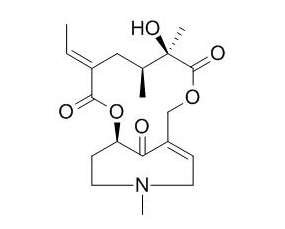Neosenkirkine
Reference standards.
Inquire / Order:
manager@chemfaces.com
Technical Inquiries:
service@chemfaces.com
Tel:
+86-27-84237783
Fax:
+86-27-84254680
Address:
1 Building, No. 83, CheCheng Rd., Wuhan Economic and Technological Development Zone, Wuhan, Hubei 430056, PRC
Providing storage is as stated on the product vial and the vial is kept tightly sealed, the product can be stored for up to
24 months(2-8C).
Wherever possible, you should prepare and use solutions on the same day. However, if you need to make up stock solutions in advance, we recommend that you store the solution as aliquots in tightly sealed vials at -20C. Generally, these will be useable for up to two weeks. Before use, and prior to opening the vial we recommend that you allow your product to equilibrate to room temperature for at least 1 hour.
Need more advice on solubility, usage and handling? Please email to: service@chemfaces.com
The packaging of the product may have turned upside down during transportation, resulting in the natural compounds adhering to the neck or cap of the vial. take the vial out of its packaging and gently shake to let the compounds fall to the bottom of the vial. for liquid products, centrifuge at 200-500 RPM to gather the liquid at the bottom of the vial. try to avoid loss or contamination during handling.
Pharmacognosy Magazine2018, 14(56):418-424
Biomedicines.2024, 12(12):2928.
South African Journal of Botany2024, 168:209-220.
Cell Metab.2020, S1550-4131(20)30002-4
Univerzita Karlova2022, 228192.
Pak J Pharm Sci.2023, 36(1):51-57.
Pharmaceuticals (Basel).2024, 17(4):462.
Neurochem Int.2023, 167:105537.
Neuropharmacology2019, 151437
Molecules.2021, 26(3):695.
Related and Featured Products
Journal of Food Composition and Analysis,2015,42; 1–7.
Hepatotoxic pyrrolizidine alkaloids in Emilia sonchifolia from Taiwan[Reference:
WebLink]
Emilia sonchifolia (L.) DC. (Lilac tasselflower, Zi Bei Cao) is used in Asian countries for food or medicinal purposes. We have investigated the hepatotoxic pyrrolizidine alkaloids (PAs) contained in E. sonchifolia. The objective was to determine profile and quantity of the PAs in E. sonchifolia samples that were collected from several towns in Taiwan.
METHODS AND RESULTS:
Pyrrolizidine alkaloids were isolated and purified from the aqueous acid extracts by use of strong cation exchange-solid phase extraction (SCX-SPE). Alkaloid extracts were analyzed using gas–chromatography mass spectrometry (GC–MS). Eleven PAs of two types were identified in E. sonchifolia (by type): (1) retronecine bases, senecionine, seneciphylline and integerrimine; (2) otonecine bases, senkirkine, otosenine, Neosenkirkine, petasitenine, acetylsenkirkine, desacetyldoronine, acetylpetasitenine, and doronine. Quantification of the individual PAs was determined by six-point linear regression curves in the range of 25–400 μg/mL of senkirkine and senecionine. The PAs were found in all plant organs of E. sonchifolia. Senkirkine was the major PA identified with concentrations up to 53.8 μg/g of dry herb. The average total PA concentration varied from a low of 33.3 μg/g to a high of 93.9 μg/g dry herb.
CONCLUSIONS:
This study will provide important information to public consumers regarding the health risk of PA-containing E. sonchifolia.



